I love the Coen Brothers.
I’m a deeply cynical person and I enjoy their distinctive brand of black comedy and dark drama.
…but this.
The Ballad of Buster Scruggs is a fascinating creature to behold. It is a movie put together from bits and pieces of cinematic tropes, conventions, and clichés, including ones borrowed from a range of genres, from ingenious physical comedy to romantic lyricism to Gothic horror. But all are united by a giddy Western revisionism centering upon a common theme: the relentless cruelty, wanton violence, deadly recklessness, and cavalier abuses of unchecked power that prevailed in the thinly and casually governed Wild West. Whether with outrageous antics or metaphysical mysteries, the Coen brothers fill the film with a subtle nose-thumbing; they’re laughing up their sleeve at the long-standing exaltation of the West as a primordial realm of titanic heroes, and at a society that even now consumes Western legends and spits them back in the form of historical verities and political pieties.
All six episodes are built like cinematic jacks-in-the-boxes, like onscreen O. Henry tales in which the Coens pack their twists with second and even third spring-traps that leave viewers flailing, giddily suspended over the edge of a cliff before the safe ground of another episode slides beneath their feet. The cartoonishness that lurks at the edges of even the most realistic of the Coen brothers’ work comes to the fore here, and the cartoon-like brevity and starkness of the episodes bring their abstract ideas to the fore as well—a philosophical bent that’s the most distinctive aspect of their work, which rises and falls with the quality and power of their ideas.
As is evident, I thoroughly enjoyed the movie.
So. This is what I’m going to do. I’m going to attempt to rank the six stories of the Buster Scruggs anthology, an almost impossible task, seeing as they vary so wildly in tone; the fact that I thoroughly enjoyed every single one of them doesn’t help either.

Spoilers ahead!
- Near Algodones
Don’t get me wrong. I thoroughly enjoyed this vignette.

I couldn’t help but laugh like crazy at the sheer ludicrousness of the plot. However, compared to the others, this was way too uncomplicated, and felt like it only existed to build up to the aforementioned meme.
Fun, nevertheless.
- The Ballad of Buster Scruggs
The titular Buster Scruggs was hilarious, and the absurd, cartoonish tone of the short made the character’s demise quite a shock; you wouldn’t think a white-clad, musical cowboy could ever lose a draw.
The story reminded me of those kiddie cowboy serials from the fifties, with a good dash of graphic violence thrown in, just to highlight the ridiculous nature of the gun-toting, musical-number singing hero. This is the quintessential western, and you can’t help but sing “Surly Joe” along with Buster.
- All Gold Canyon
The stories in this anthology are marked by tragedy and untimely death, so it’s an immense relief to see the hard-working, tough-as-nails prospector rightly rewarded for his efforts.

This short boasts jaw-dropping scenery, and makes a strangely compelling sight of an old man hard at work, grifting through mundanity to get his gold.
It can’t be easy to entertain audiences using only yourself and a prospector pan, but somehow, Tom Waits manages to retain our undivided attention.
Thankfully, he is actually rewarded for his virtue, as the black-clad cowboy fails to get the best of the wily old man; it’s a feel-good ending that feels as earned as The Shawshank Redemption.
- Meal Ticket
This story isn’t going to be enjoyed by everyone, because it is immensely cruel and depressing. But it really stuck with me, because the cruelty wasn’t gratuitous – it was sickeningly real, almost justifiable.
Liam Neeson’s immoral showman carts around a limbless boy, well-educated, and gifted with charisma. The two might share every intimate detail of their life together, but it’s apparent that the two are as distant as strangers. Not a single conversation occurs between them, the limbless boy’s only emotional outlet seemingly on stage.
He is not a person, but a possession, valued by how many coins he can attract. His passionate poetry readings are enough to draw tears, but he can’t quite draw in the crowds like a trained chicken can. Eventually, he is brutally discarded.
The fact that the showman appears to have been conned by the owner of the chicken is even more devastating; the story is a damning assessment of humanity.
- The Gal Who Got Rattled
Admittedly I’m a sucker for a well-told romance, especially one with as much heart as this one. It’s also a bit of a sneaky romance, as what “The Gal Who Got Rattled” is actually going for isn’t really revealed into a large way into the segment. But it goes to show how good the Coen’s are at just painting an atmosphere that I was just totally okay watching the exploits of this traveling caravan along the Oregon Trail, and the journey of main character Alice Longabaugh.

She really is what anchors the segment, with Zoe Kazan doing a fantastic job of painting this quiet, introverted woman alone on her own for the first time in her life. Equally compelling is her screen partner, Billy Knapp, played with gusto by Bill Heck (who I’ve never really seen as a lead in anything, but makes a hell of an impression here.) They make a fantastic pairing, their awkward chemistry thankfully ending up on the more charming than annoying side of the spectrum. The Coen’s usually don’t do straight romance , but they pulled it off with warmth and serenity here. Only a few quick scenes between the pair, and I was instantly routing for them.
…So of course it all has to end so damn tragically, in a way that is so simple in its irony, but a punch in the gut all the same.
The hero in this tale ends up being not the handsome, good-natured Billy, but Mr. Arthur, the wizened survivor of the plains.

Mr. Arthur hardly says a word until his time of action, when he rides in to save the unfortunate Alice, so close to attaining happiness. The attack from the Natives proves to be frightening indeed, and Mr. Arthur’s marksmanship and courage in the face of almost certain death is inspiring.
One of the most interesting features of this story is, of course, the big twist; Alice doesn’t survive the encounter, despite Mr. Arthur’s bravery. As an audience, we’re so used to seeing scenes of immense violence and devastation, then watching the characters react by simply shaking it off, throwing out a one-liner or two.
Thus, it was genuinely startling to see a character so impacted by the stress of a well-choreographed action scene that she shoots herself in the head; it’s a perfectly understandable decision, but one rarely made by filmmakers.
- The Mortal Remains
For me, the Coen brothers saved their best story for last; an ambiguous, macabre tale of three strangers forced to share a ride together. Where are they going, and who are the two mysterious, self-described “reapers” traveling with them?
It appears that the three are on a journey to the underworld, driven by a Charon-like coachman that refuses to stop, sharing details of their lives and varying philosophies before entering a door marked with a demon and angel.

“People are so easily distracted, so I’m the distractor with a little story. People can’t get enough of them because, well, they connect the stories to themselves I suppose, and we all love hearing about ourselves. So long as the people in the stories are us, but not us.”
Are the reapers distracting them with a song and a story? Are the three bound for eternal damnation, delight, or something in-between? It’s enjoyable to mull over, very open to interpretation, but the best part of this story wasn’t so much the mystery, but the distinctive characters.
The Coen brothers have an incredible ability to establish their characters after only a few seconds of conversation. It’s truly a remarkable talent; some films reach their end without ever fleshing out their protagonists, yet even the Coen’s side-characters are strongly defined the moment they appear on screen.
These three strangers, with their fiercely opposing personalities and perspectives, are immensely entertaining; I could have sat and listened to their conversations for hours. The opinionated, charismatic Frenchman, the self-righteous, repressed widow, and the isolated trapper who has long lost the ability to read social cues make a wonderful combination, all played perfectly by their respective actors.
While they clash fiercely throughout the coach ride, the three share a beautiful comradery in their final scene – all are immensely fearful of what lies beyond.
For me, this anthology is story-telling at its finest. We begin with a Looney Tunes-esque character and end up 2 hours later in a coach driven by a personification of Death contemplating our lives, relationships and death is nothing short of magic. Indeed, you should definitely see this anthology.
-Anant Shri
